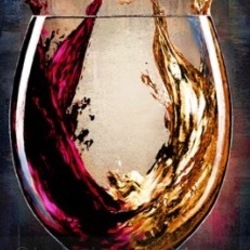Left Bank
Ridge Vineyards
Monte Bello Vineyard Cabernet Sauvignon Blend 2001
Double magnum still has a lot of life left we sure enjoyed it with the crowd!! — a month ago
Anderson's Conn Valley Vineyards
Right Bank Red Bordeaux Blend 2006
This drank very well and I enjoyed it much more than my previous bottle. An aged California claret of nicely balanced fruit & dirt. For my taste, it's near or at peak so enjoy now. From magnum. — 3 months ago
Heitz Cellar
Martha's Vineyard Cabernet Sauvignon 1991
Anytime an older Heitz Martha’s is open, it’s a treat. I’ve tried to acquire a few random bottles over the years and they have consistently impressed (‘78 and ‘01, specifically). My first early ‘90s vintage.
Quick double decant to simply get the wine off sediment as it wouldn’t be consumed from a decanter at the location I would be at.
In my experience, the distinct and typical eucalyptus notes jump right at pop, but this bottle was a little subdued early on. After an hour with the cork out, the eucalyptus, herbs, cedar and red fruit made their entrance. Compared to the ‘91 Hartwell I opened a few months ago, this was more elegant and less dense on the mid-palate. If not for the eucalyptus, I could see this being called left bank Bordeaux with 30yrs on it. Gained some darker red/underripe black fruit notes the longer it was open. Beautiful length at the finish. Bright acidity and tannin. Not getting better, but a wonderful drinking window to enjoy now. — 5 months ago
Château Latour
Premier Grand Cru Classé Pauillac Red Bordeaux Blend 2005
A knockout left bank Bordeaux. I’ve read that the 2005s may go longer than the potentially even more vaunted 2000s and I might agree based on this bottle. Decanted 5 hours. Cork in perfect shape. Amazing depth of fruit and a ton of Bordeaux earth. Nose goes on and on as does the finish. Was an excellent pairing but a very good but simple roast chicken. — a month ago
Mollydooker Wines
Two Left Feet Shiraz Blend 2021
Blend of 69% Shiraz, 16% Merlot and 15% Cabernet Sauvignon, sourced from McLaren Vale, deep Ruby color with aromas of berry fruits and sweet spice. On the palate flavors of blackberry and cherry with notes of vanilla, spice, licorice and tobacco. Fine tannins, medium+ finish ending with fruit, sweet spice and earthy notes. — 2 months ago
Penfolds
Bin 389 South Australia Cabernet Shiraz 2002
See several previous Delectable notes for this Cuvée. I have 2 bottles left after this one. Penfolds have a whopping drink window up to 2045. The colour is a pale mid crimson with a tawny rim. Mocha, dark chocolate and blackberry notes on the nose. From a low yielding cool vintage which is made for long cellaring. Absolutely superb at the moment. Great palate intensity (mulberry, black berry and dark chocolate) with mellow resolved tannins and a very long persistent finish. No wonder Penfolds tasting book is called The Rewards of Patience. — 4 months ago



Château Cheval Blanc
St. Émilion Red Bordeaux Blend 1999
Incredible wine, tons of life left. — 25 days ago
Château Léoville Poyferré
Saint Julien Red Bordeaux Blend 2014
Château Léoville Poyferré 2014
Saint-Julien, Bordeaux, France 🇫🇷
Overview
A distinguished Deuxième Cru Classé (Second Growth) from Saint-Julien, Château Léoville Poyferré has been elevated under the stewardship of the Cuvelier family and Michel Rolland’s consultancy. The 2014 vintage is a classic Bordeaux blend comprised of 60% Cabernet Sauvignon, 35% Merlot, 3% Cabernet Franc, and 2% Petit Verdot. This cooler year yielded wines with notable polish, freshness, and age-worthy structure.  
Aromas & Flavors
Expressive and refined, the bouquet opens with blackcurrant, cassis, and plum, framed by cedar, graphite, violets, and aromatic spice. The palate is layered with ripe red and dark fruits, along with hints of tobacco, pepper, and soft oak—a harmonious reflection of balanced ripeness and terroir depth.  
Mouthfeel
Medium to full-bodied, with smooth yet structured tannins and vivid acidity. The finish is long and mineral-tinged, echoing Saint-Julien’s limestone terroir while expressing both strength and grace.
Winemaking Notes
Vinified traditionally and aged in French oak barrels (predominantly new), the 2014 benefits from meticulous attention to extraction and maturation, resulting in elegant concentration and finesse.  
Food Pairing
Wonderful with roast lamb, herb-crusted beef, or rich mushroom dishes. Decanting for an hour enhances its layered complexity.
Verdict
A classic expression of Left Bank finesse and depth, Château Léoville Poyferré 2014 strikes an artful balance between fruit, structure, and refinement. Enjoy now with decanter or cellar it to explore its evolution over the next decade.Cheers! — 3 months ago









Vijay Parikh
Truly amazing after a 20 minute decanting a profound Margaux 1982with all the intellect that left bank demands — 12 days ago